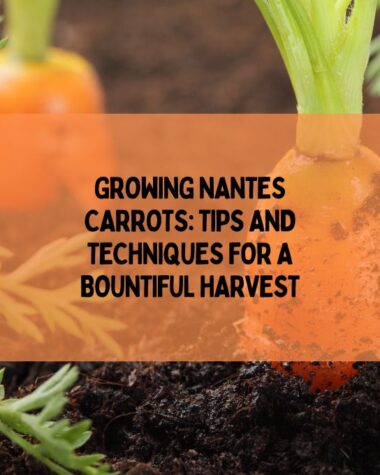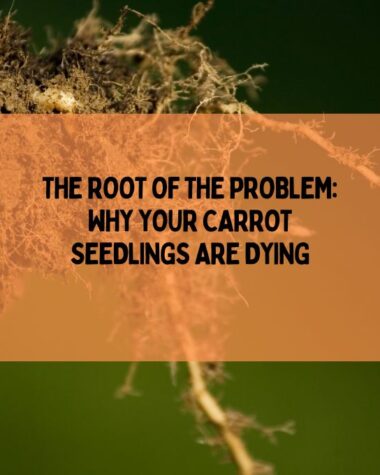How To Grow Delicious Danvers Carrots? Prepare the soil, Plant the seeds, Care for the plants, and Harvest the carrots.
Growing your vegetables can be a rewarding and satisfying experience, and one of the most popular crops to grow is carrots. Danvers carrots are a variety that is known for their sweet and crunchy texture, making them perfect for snacking or adding to your favorite dishes.
Our step-by-step guide teaches how to grow the most delicious and nutritious Danvers carrots. From preparing the soil to harvesting the crop, in this article, I will cover all the essential steps to ensure a bountiful harvest of sweet and crunchy carrots.
This comprehensive guide will show you how to grow Danvers carrots from seed to harvest and enjoy the freshest, most delicious carrots possible.
What You Will Need: How to Grow Delicious Danvers Carrots?

To grow Danvers carrots, you will need the following:
- Danvers carrot seeds
- Garden bed or container with well-draining soil
- Compost or other organic matter
- Garden fork or shovel
- Watering can or hose
- Mulch
- Fertilizer (optional)
Growing Tips
If you cannot access a garden bed, you can grow Danvers carrots in a container. Choose a container at least 12 inches deep and wide, with drainage holes in the bottom. Fill the container with a good-quality potting mix, and make sure it has good drainage.
Related Read
- How To Grow Lemon Cucumber Plant In Your Vegetable Garden?
- How To Grow Pumpkin Seeds In Pots?
- What is Zucchini Summer Squash and How to Plant Zucchini from Seeds?
Step-by-Step Instructions: How to Grow Delicious Danvers Carrots
- Prepare the soil

Loosen the soil in your garden bed or container with a garden fork or shovel. Also, check soil temperature.
Add compost or other organic matter to the soil to improve its texture and nutrient content.
Smooth out the soil surface and create furrows for planting the seeds.
- Plant the seeds

Sow the Danvers carrot seeds thinly along the furrows
Cover the seeds with a thin layer of soil and gently tamp it down to allow the seed to germination
Water the soil well using a watering can or hose
- Care for the plants

Water the carrot plants regularly, ensuring the soil stays moist but not soggy.
Apply a layer of mulch around the plants to help retain moisture and suppress weeds.
If desired, apply a balanced fertilizer every 4-6 weeks to promote growth and yield.
- Harvest the carrots

Danvers carrots typically take around 70-80 days to mature
Check the size of the carrots by gently pulling back the soil around the top of the root
When the carrots have reached the desired size, gently pull them from the soil, taking care not to damage the roots
Also, Read
- 17 Plants You Can Grow With Carrots As Companions
- Can You Grow Carrots? / What Are Some Common Carrot Varieties?
- Preventing The Spread Of Root-Knot Nematodes To Save Carrot Crops
Benefits Of Growing Danvers Carrots
Danvers carrots are a variety of carrots that offer numerous benefits when grown in your garden. Here are some of the benefits of growing Danvers carrots:
- Nutritional Value: Danvers carrots are a rich source of essential vitamins and minerals like vitamin A, potassium, and fiber, making them a great addition to any healthy diet.
- Easy to Grow: Danvers’ carrots are easy to grow, making them an excellent option for beginner gardeners. They can be grown in a garden bed or container and do not require extensive care or maintenance.
- High Yield: Danvers’ carrots are known for their high yield, meaning you can harvest a significant amount of carrots from just a few plants.
- Long Shelf Life: Danvers carrots have a longer shelf life than other varieties, making them an excellent option for storing and using in your favorite recipes throughout the year.
- Versatility: Danvers carrots are versatile and can be used in various dishes, from salads and stews to soups and stir-fries.
Growing Danvers carrots is a great way to add fresh and nutritious vegetables to your diet while enjoying the satisfaction of growing your food.
Also, Read
- How to Grow Tomatoes – The step-by-step Guide from Seeds to Harvest
- How to Grow Delicious Aubergines in Your Polytunnel?
Conclusion
Growing Danvers carrots can be a fun and rewarding experience, and with our comprehensive guide, you now have all the information you need to get started.
I hope you enjoyed this tutorial and encourage you to share your thoughts and experiences in the comments below. Remember, growing your vegetables is rewarding and a great way to eat healthier and more sustainably.
Happy Gardening!
Frequently Asked Questions
Q1. What is the difference between Danvers carrots and other carrot varieties?
A. Danvers carrots are a variety of carrots known for their large size and tapered shape. They are also known for their sweetness and tenderness. Compared to other carrot varieties, Danvers carrots have a higher yield, longer shelf life, and are easier to grow.
Q2. Can Danvers’ carrots be grown in containers?
A. Yes! Danvers’ carrots can be grown in containers if the container is at least 12 inches deep and has good drainage. It is essential to ensure the soil is loose and well-draining to avoid stunted growth or rotting.
Q3. How do I know when to thin my Danvers carrot seedlings?
A. Thin Danvers carrot seedlings when they are about 2 inches tall, leaving only one plant every 3-4 inches. This gives the remaining plants enough space to grow and develop properly.
Q4. What common problems can occur when growing Danvers carrots?
A. Some common problems that can occur when growing Danvers carrots include pests such as carrot rust fly and carrot weevil, as well as diseases like carrot blight and damping off. It is essential to take preventative measures such as crop rotation and proper soil drainage to avoid these problems.
Q5. What are some tips for using Danvers carrots in recipes?
A. Danvers carrots are versatile and can be used in various recipes. They are great roasted, steamed, or even raw in salads. They also pair well with flavors like ginger, garlic, and honey. Try roasting Danvers carrots with olive oil and your favorite seasonings for a simple and delicious side dish.







